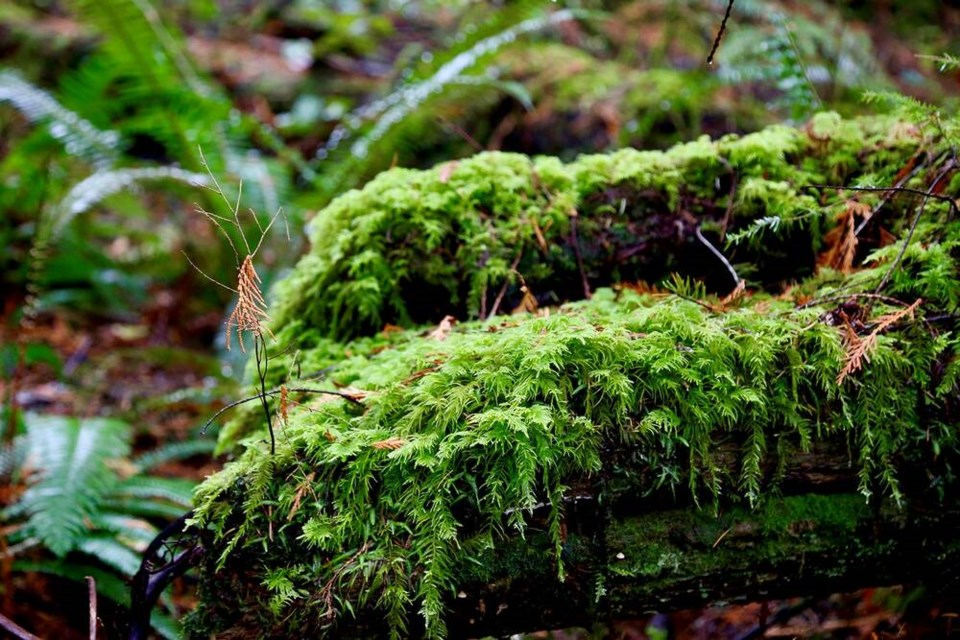Studying permaculture and natural systems changed how I see, hear, feel and consider everything. It changed my mind, literally and figuratively, for the better.
I see myself clearly as part of nature and not separate from it. I see the cruelty and futility in trying to control nature or bend her will to ours.
Mosses for example, I now know are not something to be purged from lawns or power-washed from sidewalks. Moss is a living breathing ally for capturing and storing water, cleaning the air, breaking down minerals into soil, reducing run-off and erosion, fixing nitrogen, creating habitat, stabilizing riverbanks and streams, managing humidity and air temperature, and providing gorgeous organic living mulch.
Bryophytes – non-vascular mosses, liverworts and hornworts – have been around for over 400 million years, and their story is epic.
Early this morning early, while pulling tiny puffs of invasive non-native turf grass from the velvety moss runways that checkerboard the Roman pavers in the driveway, I paused to reflect. I was grateful for the living cushion beneath my feet, and I considered conversations I have had of late with well-meaning people whose livelihoods depend on killing our lush green partners in ecosystem management.
Recently, a charming young man offered his power-assisted services in ridding our expansive pavers of the green scourge. He ensured that a mild herbicide would slow the return of the offenders.
We chatted ultimately about why exactly I might want to do that, and he told me with some conviction that lawns should be green and pavers should be clean. “Says who?” I inquired. “Well, everyone,” he answered.
And therein lies the problem. There was a time way back when I too coveted moss and weed-free pavers, dense moss-free lawns, and bare black earth. But we know better now, or at least we should.
I asked the young man if he knew about the biology and ecology of moss, or that “cides” (Latin “to kill”) in the water table kill wantonly. He didn’t know but he was curious. He listened politely, then continued knocking on doors.
There is no shortage of information, documentaries, research studies, influencers and citizen scientists lobbying for change regarding the use of fungicides, herbicides and pesticides. It is near impossible not to see the evidence all around us, yet still we resist because we want to fit in or keep our jobs.
It isn’t easy being different or bucking convention. The alternative though is not being at all. We have to stop killing this planet we call home or it won’t matter how moss-free our lawns are, or how perfect our pavers.
Moss is cool. Moss rocks!
Moss lives everywhere in our gardens – in sun, shade and in between. Moss mulches for weeds, fills in the gaps, keeps water in place, sculpts landscapes, houses wee creatures, provides nesting material for birds and squirrels, metabolizes particulate and dampens the sound of gas-powered everything.
Best of all, as moss converts CO2 into oxygen, it respires the most delicious rainforest-scented goodness into the air at every level, from beneath our feet to the tip of the tallest tree.
A simple way to up your moss game and quickly, is to whip up a smoothie of moss and organic yogurt or buttermilk. Brush the slurry on rock and stone, or spray it on soil. Keep moist and soon enough, you should be rewarded with a lush living carpet of green.
Meaningful federal legislation prohibiting cosmetic residential use of herbicides, fungicides and insecticides could change everything, literally and figuratively.
Laura Marie Neubert is a West Vancouver-based urban permaculture designer. Follow her on Instagram @upfrontandbeautiful, learn more about permaculture by visiting her Upfront & Beautiful website or email your questions to her here.
For a taste of permaculture, watch the video below:




